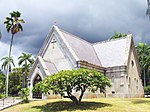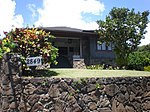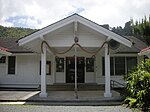First Unitarian Church of Honolulu
The First Unitarian Church of Honolulu is the largest Hawaii-based congregation within the Unitarian Universalist Association. It is located at 2500 Pali Highway in the Nu'uanu Valley. The congregation was founded in 1952 as a lay fellowship. The fellowship was unusual for its time because its leadership consisted of women (Rosemary Mattson as chairwoman and Ruth Iams as program director) and because it made efforts to engage in interfaith dialogue with Jewish and Buddhist congregations in Honolulu.In September 1969, the church made national headlines when it offered refuge to U.S. service members protesting the war in Vietnam. The service members were arrested by military police within the church grounds. The resulting action brought about an unsuccessful lawsuit filed by the church against the military - Bridges v. Davis, 443 F.2d 970 (9th Cir., 1971). The private memorial service for Madelyn Dunham, grandmother of US President Barack Obama, was held there in December 2008. It is also where President Obama attended Sunday School during his youth.A new mission statement was adopted on April 15, 2012, to "boldly grow compassion, justice, and joy."
Excerpt from the Wikipedia article First Unitarian Church of Honolulu (License: CC BY-SA 3.0, Authors).First Unitarian Church of Honolulu
Pali Highway, Honolulu Nuuanu
Geographical coordinates (GPS) Address Nearby Places Show on map
Geographical coordinates (GPS)
| Latitude | Longitude |
|---|---|
| N 21.329983333333 ° | E -157.84463333333 ° |
Address
Pali Highway
Pali Highway
96817 Honolulu, Nuuanu
Hawaii, United States
Open on Google Maps









